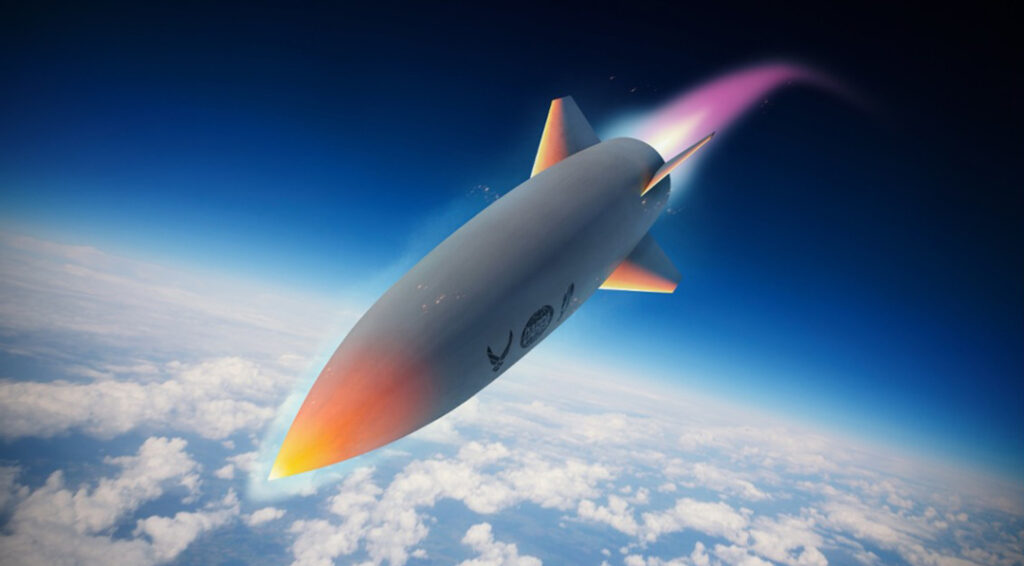THE WATCH STAFF
With a record-setting flight test, the U.S. Air Force and the Defense Advanced Research Projects Agency (DARPA) have reached another milestone in the development of a Hypersonic Air-breathing Weapon Concept (HAWC).
The vehicle tested was the Lockheed Martin version of a HAWC cruise missile, which set a record for hypersonic flight — greater than five times the speed of sound — under scramjet power, DARPA reported in an April 5, 2022, news release. The test was the second successful flight in the agency’s HAWC program. In 2021, a vehicle configuration from the contractor Raytheon also reached hypersonic flight.
The Lockheed Martin vehicle, pictured in an artist’s rendering, was boosted by an Aerojet Rocketdyne scramjet engine. It likely achieved about 327 seconds of hypersonic flight under scramjet power after its release from a carrier aircraft, according to an April 6 report by Air Force Magazine and based on figures provided by DARPA. The test vehicle reached altitudes greater than 65,000 feet and flew for more than 300 nautical miles, DARPA said.
“This test set a record for scramjet endurance, and we believe it’s an inflection point on the path to reclaiming U.S. leadership in hypersonic weapons,” DARPA’s director, Stefanie Tompkins, said April 6 before the U.S. Senate Armed Services subcommittee on emerging threats and capabilities, according to Air Force Magazine.
Russia and the People’s Republic of China have either tested or deployed hypersonic missiles.
A scramjet operates by the combustion of fuel in a stream of air compressed by the forward speed of a vehicle, according to a NASA fact sheet first published in 2006. For the engine to ignite, the vehicle must be moving at hypersonic speed, so a booster is used for the initial portion of the flight. The airflow through the engine then remains supersonic.
Unlike a slower conventional cruise missile, the HAWC’s kinetic energy would be enough to destroy most targets without the need for an explosive warhead.
“We are still analyzing flight-test data but are confident that we will provide the U.S. Air Force and Navy with excellent options to diversify the technology available for their future missions,” Andrew “Tippy” Knoedler, HAWC program manager in DARPA’s Tactical Technology Office, said in the news release.
The Air Force has signaled that it is emphasizing the HAWC over the boost-glide AGM-183A
Air-Launched Rapid Response Weapon (ARRW) as that missile has yet to make a free flight, according to Air Force Magazine. Boost-glide systems place a maneuverable glide vehicle atop a ballistic missile or rocket booster.
Air Force budget director Maj. Gen. James D. Peccia III, in a March 28 media briefing, said his service is “not walking away” from ARRW.
“It’s funded in FY [fiscal year] ’23 and then we’ll make an assessment after that,” Peccia said of the Air Force’s budget request, according to a U.S. Department of Defense transcript. Still, the Air Force isn’t planning to procure any ARRWs, according to the website Defense News. Peccia said any remaining procurement funding for the missile in 2022 would likely be reallocated for research and development.
“ARRW still has to prove itself,” Air Force Secretary Frank Kendall said on March 9, according to Defense News.
The budget proposal released March 28 seeks to increase spending on developing hypersonic prototyping from the near U.S. $509 million lawmakers approved in fiscal 2022 to U.S. $577 million in 2023, Defense News reported.
IMAGE CREDIT: LOCKHEED MARTIN

